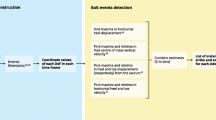Abstract
Since the advent of electromyogram recording, precise measures of tremor and gait have been used to study movement disorders such as Parkinson’s disease. Now, a wide range of accelerometers and other motion-tracking technologies exist to better inform researchers and clinicians, yet such systems are rarely tested for accuracy or suitability before use. Our inexpensive test-rig can produce sinusoidal displacements using a simple cantilever system driven by a subwoofer. Controlled sinusoids were generated using computer software, and the displacement amplitudes of the test-rig were verified with fiducial marker tracking. To illustrate the use of the test-rig, we evaluated an accelerometer and an electromagnetic motion tracker. Accelerometry recordings were accurate to within ±0.09 g of actual peak-to-peak amplitude with a frequency response close to unity gain between 1 and 20 Hz. The electromagnetic sensor underestimated peak displacement by 2.68 mm, which was largely due to a diminishing gain with increasing frequency. Both sensors had low distortion. Overall sensitivity was limited by noise for the accelerometer and quantisation resolution for the electromagnetic sensor. Our simple and low-cost test-rig can be used to bench-test sensors used in movement disorders research. It was able to produce reliable sinusoidal displacements and worked across the 1- to 20-Hz frequency range.



Similar content being viewed by others
References
Audacity Team (2014) Audacity 2.0.5. http://audacity.sourceforge.net/. Accessed 2 June 2014
Bain PG (1997) The effectiveness of treatments for essential tremor. The Neurologist 3:305–321. doi:10.1097/00127893-199709000-00003
Billinghurst M, Kato H (2014) ARToolKit Benchmarks. http://www.hitl.washington.edu/artoolkit/documentation/benchmark.htm. Accessed 15 Sep 2014
Dosch J (2007) Low frequency accelerometer calibration using earth’s gravity. In: IMAC XXV: conference & exposition on structural dynamics. http://sem-proceedings.com/25i/sem.org-IMAC-XXV-s28p04-Low-Frequency-Accelerometer-Calibration-Using-Earths-Gravity.pdf
Elble RJ (2005) Gravitational artifact in accelerometric measurements of tremor. Clin Neurophysiol 116:1638–1643. doi:10.1016/j.clinph.2005.03.014
Fahn S, Elton RL, Committee UD (1987) Unified Parkinson’s disease rating scale. Recent Dev Park Dis 2:153–163
Fahn S, Tolosa E, Marin C (1993) Clinical rating scale for tremor. Park Dis Mov Disord 2:271–280
Gade S, Schack T, Thorhauge O, Herlufsen H (2008) Transducer response equalisation. In: Proceedings of IMAC XXVI Conference Exposition on Structural Dynamics
Giuffrida JP, Riley DE, Maddux BN, Heldman DA (2009) Clinically deployable Kinesia™ technology for automated tremor assessment. Mov Disord 24:723–730. doi:10.1002/mds.22445
Griffiths RI, Kotschet K, Arfon S et al (2012) Automated assessment of bradykinesia and dyskinesia in Parkinson’s disease. J Park Dis 2:47–55
Heldman DA, Filipkowski DE, Riley DE, et al (2012) Automated motion sensor quantification of gait and lower extremity bradykinesia. In: Engineering in Medicine and Biology Society EMBC, 2012 Annual International Conference on IEEE. IEEE, pp 1956–1959
Litwhiler DH (2011) A custom vibration test fixture using a subwoofer. Int J Mod Eng 11:205
Maetzler W, Domingos J, Srulijes K et al (2013) Quantitative wearable sensors for objective assessment of Parkinson’s disease. Mov Disord 28:1628–1637. doi:10.1002/mds.25628
O’Suilleabhain PE, Dewey RB (2001) Validation for tremor quantification of an electromagnetic tracking device. Mov Disord 16:265–271
Singh H (2014) Accelerometer Testing Instructions. In: MEMS Lab. http://memslab.blogspot.com.au/2013/01/accelerometer-testing-instructions.html. Accessed 2 June 2014
Spyers-Ashby JM, Stokes MJ, Bain PG, Roberts SJ (1999) Classification of normal and pathological tremors using a multidimensional electromagnetic system. Med Eng Phys 21:713–723
Tee KS, Awad M, Dehghani A et al (2011) Triaxial accelerometer static calibration. In: Proceedings of World Congress, Engineering 3
Wile DJ, Ranawaya R, Kiss ZHT (2014) Smart watch accelerometry for analysis and diagnosis of tremor. J Neurosci Methods 230:1–4. doi:10.1016/j.jneumeth.2014.04.021
Acknowledgments
We are grateful for the funding received from the Colonial Foundation to complete this study, and the authors would also like to thank Rodney Millard and Mark Harrison for providing expertise and advice. The Bionics Institute acknowledges the support it receives from the Victorian Government through its Operational Infrastructure Support Program. We thank the reviewers for their useful comments regarding the original manuscript.
Conflict of interest
The authors do not have any related conflict of interest.
Author information
Authors and Affiliations
Corresponding author
Rights and permissions
About this article
Cite this article
Perera, T., Yohanandan, S.A.C. & McDermott, H.J. A simple and inexpensive test-rig for evaluating the performance of motion sensors used in movement disorders research. Med Biol Eng Comput 54, 333–339 (2016). https://doi.org/10.1007/s11517-015-1314-7
Received:
Accepted:
Published:
Issue Date:
DOI: https://doi.org/10.1007/s11517-015-1314-7




